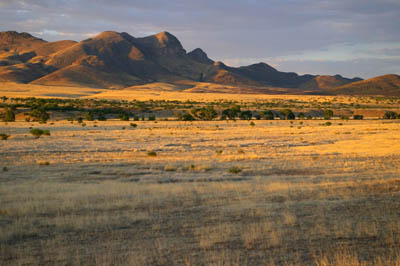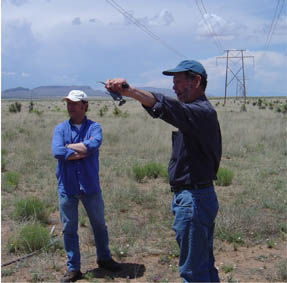To give you a deeper sense of our Nature and History at the Nation's Edge summer institute, we have posted our preliminary daily schedule, including institute readings and recommended resources, below. This preliminary schedule is subject to change. You will soon be able to download the complete preliminary detailed schedule and readings as a .pdf file.
WEEK ONE: University of Arizona, Tucson
Sunday, 14 June
Participants arrive in Tucson, Arizona, and settle into their housing accommodations. At an evening barbeque held at Dr. Katherine Morrissey’s home, participants, principal faculty, and local scholars will have the opportunity to meet each other in an informal setting. There will be an introductory talk about the program, and participants will be invited to describe their research interests and teaching goals.
Monday, 15 June
The first full day of the Institute will include introductions and overviews of borderlands history and environmental history. There will also be administrative time set aside to allow you to arrange for CatCards, parking passes, gym access, and other campus-related needs. Our seminar meeting room at the University of Arizona Library is located in the Special Collections, enabling us to utilize the rich manuscript collections for the seminars. After opening comments by Dr. Katherine Morrissey (History, UA) introducing the main themes of the Field Institute, participants will discuss their initial perceptions of the Southwest, the border and its environment. Dr. Samuel Truett (History, UNM) will guide the morning seminars on borderlands history. In the afternoon Dr. Thomas Sheridan (Anthropology, UA) and Dr. Morrissey will focus on regional environmental history. Seminars will end by 3pm to provide participants time for reading and reflection.
Readings: Miguel Tinker Salas, In the Shadow of Eagles, pp. 1-16; J.R. McNeil, “Observations on the Nature and Culture of Environmental History,” History and Theory 42 (December 2003): 5-43; Thomas R. Dunlap, “Creation and Destruction in Landscapes of Empire,” pp. 207-225.
Recommended: David Weber, The Spanish Frontier in North America; Eric V. Meeks, Border Citizens: The Making of Indians, Mexicans and Anglos in Arizona; Oscar Martinez, Border People: Life and Society in the U.S.-Mexico Borderlands; Edward Spicer, Cycles of Conquest; Samuel Truett and Elliott Young, Continental Crossroads: Remapping U.S.-Mexico Borderlands History, pp. 1-32; Mark Fiege, “Private Property and the Ecological Commons in the American West,” pp. 219-231.
Tuesday, 16 June
We’ll spend the day at the Arizona-Sonora Desert Museum, the world-renown outdoor natural history museum located 12 miles west of Tucson. With the assistance of Dr. Debra Colodner, Associate Director of the Center for Sonoran Desert Studies, we have arranged an introduction to the natural history of the Sonoran Desert. Keeping in mind that you will still be acclimatizing to the summer desert heat, we will start in the cooler morning temperatures with the outdoor portion: staff-guided tours of the museum (in groups of 10-12) that offer an introduction to biotic communities, plants, animals and geology of the Sonoran Desert. We’ll retreat to their classroom for a richly illustrated powerpoint presentation on the diversity of plants and animals inhabiting the Sonoran Desert with a focus on adaptations to each unique environment, followed by time for discussion. After lunch at the Museum’s Ironwood Café, we will return to the classroom where Dr. Dan Flores (History, University of Montana) will provide the historical context for bioregional studies and lead the seminar discussions comparing the different perspectives offered by the Conrad Bahre and Nathan Sayre readings, and the Aldo Leopold and George Henderson readings. A second Arizona-Sonora Desert Museum staff presentation, A Taste of Place, will illustrate the interaction of people and the environment in the Sonoran Desert through time, including a sampling of native foods and demonstrations of tool-making and use. We will use vans from the UA Motor Pool for transportation to and from the Arizona Sonora Desert Museum.
Readings: Dan Flores, “Place: Thinking about Bioregional History,” pp. 89-106; Aldo Leopold, “Wilderness as a Land Laboratory;” Nathan Sayre, Ranching, Endangered Species, and Urbanization in the Southwest , pp.55-81; George L. Henderson, “What Else We Talk about When We Talk about Landscape,” pp. 78-91.
Recommended: Steven J. Phillips & Patricia Wentworth Comus, A Natural History of the Sonoran Desert; Dan Flores, Horizontal Yellow: Nature and History in the Near Southwest; Michael Logan, The Lessening Stream: An Environmental History of the Santa Cruz River.
Wednesday, 17 June
Today we’ll turn our attention to the uses of photographic evidence, with a particular focus on repeat photography, for borderlands and environmental history. We’re excited about a special opportunity to contrast the work and approaches of two visiting scholars: photographer Dr. Mark Klett (Arizona State University) and plant ecologist Dr. Raymond Turner (University of Arizona), leaders in their respective fields in the use of rephotography and repeat photography. Turner’s borderlands vegetation change studies, exemplified in The Changing Mile Revisited (2003), involve old landscape photographs that, when matched exactly, provide detailed insights into the kinds of changes that transpire under various climatic and cultural influences. Klett’s rephotographic projects, exemplified in Third View, Second Sights (2004), revisit 19th-century photographs of the West then reshooting them not only to show a century of change, but also to offer commentary on the relations of time/space and on the dialectics of nature/culture. The afternoon features a tour and print viewing workshop at the Center for Creative Photography, to make use of its vast collection of photographs and archival materials, with Curator of Education Cass Fey. Seminars end at 3pm to provide time for reading and reflection.
Readings: Raymond M. Turner, ”Introduction” and “The Patterns of Change,” in The Changing Mile Revisited, pp. xiii-xvi, 248-77; Mark Klett, Third View, Second Sights website: http://www.thirdview.org/
Recommended: Mark Klett, Third View, Second Sights: A Rephotographic Survey of the American West; Raymond M. Turner, et al., The Changing Mile Revisited; Grady L. Webster and Conrad J. Bahre, eds., Changing Plant Life of La Frontera: Observations on Vegetation in the United States/Mexico Borderlands; Robert R. Humphrey, 90 Years and 535 Miles: Vegetation Changes along the Mexican Border.
|

